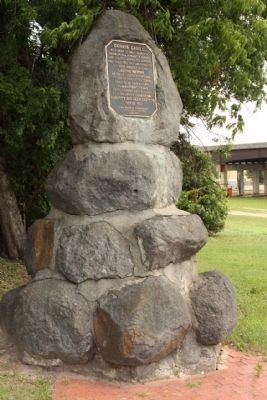Most Augustans know that the Butt Bridge that spans the Augusta Canal at 15th Street is a memorial to Archie Butt, a hero on the RMS Titanic who is remembered for putting women and children in the lifeboats before going down with the ship.
However, there is another monument at the site that is dedicated to another hero who drowned in the canal trying to save a life. That man was an Irish immigrant by the name of Dennis Cahill.
As St. Patrick’s Day approaches, the local Ancient Order of the Hibernians, an Irish fraternity, will place a wreath on the rough stone monument on Friday, March 8 at 1 p.m.
Cahill’s story may have ended in 1909 with his drowning, but his story began really half a century before when massive waves of Irish began migrating in huge numbers. Earlier waves meant that, according to the Library of Congress, at one point the Irish were the second largest European ethnic group in America, second only to the English.
Contrary to some belief, the Irish were not brought over to America as slaves. Most historians agree that some Irish did come over as indentured servants, an arrangement where they would work for several years to pay off their passage across the Atlantic.
MORE: Two more qualify in Columbia County, including Democrat candidate for coroner
Most of the early Irish who immigrated were skilled laborers or farmers who dreamed of living in a land where they could own property and did not have to pay tithes to the established Episcopal church of Ireland, according to the Library of Congress.
Due to their deep-seated hatred for the British, the Irish immigrants were among the first to support independence, and many of them died in the Revolution.
Former Irish Ambassador to the United States, Daniel Mulhall, wrote that the potato blight ,as well as further internal conflicts, caused massive surges of immigration to America in the mid 19th century.
Partially due to the sheer number of Irish landing in the port cities, many of the immigrants did face discrimination as the Irish tended to speak their mind and didn’t mind defending themselves with their fists.
This cultural fact developed the unearned reputation of the Irish as drunken layabouts in some quarters.
That was not the case of the Irish that settled into Augusta. In fact, many of them rose to prominence as mayors, editorialists and civil leaders; the most famous of them all being Patrich Walsh, whose statue still stands on the grounds of the Federal Court complex in downtown Augusta.
Unlike Walsh, there is not much known about Dennis Cahill.
It is likely that his family immigrated and ended up in Augusta long after the extension of the Augusta Canal. He was likely a Catholic and, like many of his compatriots, came to America for his religious freedom.
It is known that Cahill worked for the city of Augusta as some type of maintenance worker on the canal; his job had him out at the canal on a daily basis.
Even today, the Augusta Canal looks like a lazy body of water when viewed from afar. In reality, the canal flows at a rate of around 13 knots or 15 miles per hour and is a dangerous waterway for even the best of swimmers.
One reason we know that Cahill worked everyday at the canal is because he was credited with saving others who had fallen into the body of water.
On July 29, 1909, Cahill’s “luck of the Irish” ran out.
That day, 9 year-old Dallas Kitchens was purportedly taking lunch to her aunt at Enterprise Mill. According to press reports at the time, Cahill watched as the girl lost her balance and fell through a hole in the footbridge.
Cahill dove in after the child, but the water swept them both away to a watery death.
As stated, a monument was erected several years later. However, unlike the other stately monuments that line the downtown roadways, Cahill’s monument is made of boulder stones, testifying to a rough and tumble Irish-Augustan who selflessly sacrificed his life in service to others.
…And that is something you may not have known.
Scott Hudson is the Senior Investigative Reporter and Editorial Page Editor for The Augusta Press. Reach him at scott@theaugustapress.com









